“94% of consumers report that they are likely to purchase more from a company with (a)“very good” customer experience,” according to Qualtrics research.
What defines a great experience for your one reader? Ask your audience. Content marketing and copywriting start with audience research.
After reading this blog post, you’ll be able to:
“Get closer to your customers than ever. So close that you can tell them what they need before they realize it themselves.”
Steve Jobs
The first step of copywriting is getting your audience’s attention; the only way to get it is to walk a mile in their shoes. Listen to your one reader. Personalize your copywriting for different segments of your audience, and you’ll convert more people.
Insights into your buyer’s journey allow you to speak to them directly at each stage. Learning about their motivations and anxieties will have you speaking your one reader’s language. Understanding their desires inspires action. Use their words to communicate how your product makes them a better version of themselves.
What is Audience Research
Voice of Customer (VoC) research is pulled from prospective customers and past customers’ voice of customer data. It’s discovering your audience’s pain points, preferred keywords, buying behaviors, language, and more. VoC is everywhere, so get as much information as possible.
Swipe words and phrases from your audience. Double down on understanding your audience by starting with the rule of one. Determine the perfect lead for your research or let the research determine who the perfect lead is.

McDonald’s used audience research to make significant changes.
Look no further than McDonald’s for an example of audience research making a significant change in a company’s marketing (and menu). After research and pressure from their customers, McDonald’s started serving healthy and organic food.
The Rule of One
The rule of one consists of:
Focused web copywriting comes from a clear understanding of your audience. Your one reader represents people in your audience interested in your products. Researching the perfect lead allows you to craft specific copy because you know what details are important to them. You can uncover trends like how they find and consume your content.
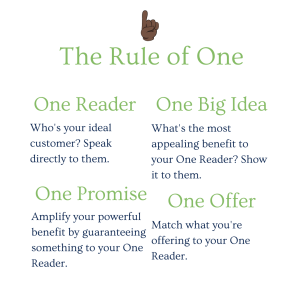
The rule of one and audience research go hand in hand.
Your one reader is the foundation of your audience. You have to know your ideal prospect to persuade them. You can’t write for everyone. You’ll end up reaching no one. The best suited one readers:
Speak directly to your one reader; they represent the target audience you want to convert into customers. During audience research, look for specific examples to convince your one reader to buy your product.
What are you Looking for?
You’re narrowing your focus so you can expand your reach. You’ll want to look for:
Discovering the problems/pains of your one reader helps you because customers only care when you solve their problems. As you’re looking, remember recurring messages and ideas become trends. You’ll find objections to your solution and your audience’s biggest gripes. Address them head-on in your copy.
The research will outline your customer expectations, so you’ll know where they hang out online. Plus, you’ll find:
Using external and internal research, swipe your one reader’s:
All the information you gathered will help you develop the one big idea and one promise for your 1 offer.
External Audience Research
The converting messaging you are trying to write isn’t inside your head, it’s outside in the world. Do research to find what’ll motivate your one reader to buy. Get to know your one reader through research before you write anything. Find the best words from the people who are already customers or customers of your competitors.
“Research writes 50-80% of your copy for you.”
Samuel Woods
Interviews
In Pain Killer Marketing (2008), Chris Stielhl and Henry DeVries show that 12 to 15 one-on-one interviews will generate about 80% of all possible pain points for your segment.
Learn from your current customers, and you’ll get more customers. Asking the right questions reveals all the right answers. Gain insight by going straight to the customers and getting the answers you need from the horse’s mouth.
Interview the following people to get the best answers:
Blog posts often have quotes from customer interviews that give important perspectives on their pain points. Youtube has interviews with customers from your competitors. Also, check out people using reviews on your product or your competitors’ products.
You can ask questions like:
- What does your perfect customer really want?
- How can your product or service solve their problem(s)?
- What factors motivate their buying decisions?
- Why do your existing customers choose your business over your competitors?
- How will their lives be improved?
- What makes your business so different that prospective customers should choose your products or services?
Interview up to 5 people but no more than 12. You can survey people if interviews are too time-consuming or you don’t have enough customers.
The Power of Interviews
P&G hired a researcher to interview customers to see how they used Febreeze after their original campaign flopped.
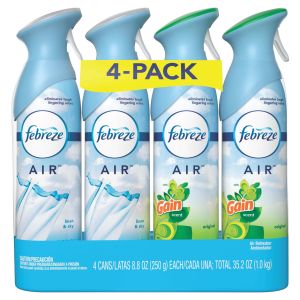
Audience research 2x Febreeze’s sales
During an interview, a housewife revealed it feels like a “mini-celebration” after she sprays Febreeze at the end of cleaning a room. Using this insight, they positioned FeBreeze as the reward for cleaning a room instead of including it in their audience’s existing routine. As a result, the sales doubled within 2 months.
Surveys
Use surveys to find messaging because they reveal in-depth data about purchasing your solution. It’ll help you understand your value proposition from your one reader’s point of view. Probe your current audience for answers and find out what they are thinking about your:
That’ll help determine the messaging hierarchy. Keep your survey short, so it only takes 5 minutes to complete and distribute via social media or email. Survey the following people to get the best answers:
Examples of Survey Questions
Try these online survey platforms to get important information about your one reader:
Social Media & Audience Research
Social media is often the first touchpoint of your business for your audience. It’s a huge resource for interacting with your customers. Utilize it by:
Use social media to understand how people feel about you and your competitors.
Social Media Polls
Most social media platforms will allow you to create a poll, so utilize the tool to ask your audience what they want from you.
Social Listening & Audience Research
Monitor social media channels for mentions of your:
- Brand
- Competitors
- Product
- Keywords
- More
Track, analyze, and respond to your customers. You’ll discover frustrations about your industry and find the most important pain points.
Competitor Content/Products
Conduct a competitive content and product analysis to get to know your competition. Find the motivation that they are touching on to get conversions. Highlight your competitor’s messaging, so you know what your one reader has seen already. Plus, you’ll know exactly how to position your product.

Use competitor’s social media ads to see how they position their product
Make sure you document their:
Swipe copy that differentiates your product from theirs. Look up industry/market news and trends to determine how your web copy will stand out.
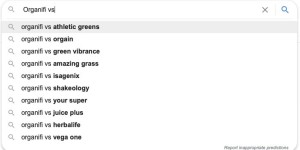
Use Google to see what competitors are doing
Case Studies
Competitors’ case studies tell stories of how their products transformed their lives. Word of mouth is still the most powerful marketing tool, so the insight you’ll get provides an opportunity to find your positioning in the market. Take note of:
Identify who they attract and how they use their case studies to generate more customers.
Review Mining & Audience Research
“78% of Internet users conduct product research online.”
Hubspot
If your customers and prospects are researching the right product online, you should be too. Focus on review mining in forums, blog/articles comments, and other sources of golden nuggets.

Swipe language, problems, and patterns during audience research
Amazon Reviews
Amazon review mining is looking up products like yours (competitors) and pulling out interesting insights into your one reader’s objections, anxieties, and more. When searching Amazon look for:

People will tell you what to write

Review mining is a key component of audience research
The front page of the internet’s subreddits has insight into an abundance of industries, products, services, and beyond.
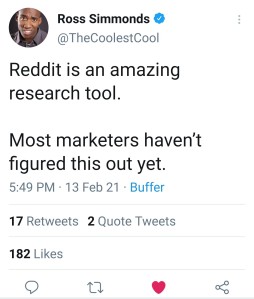
Reddit is a great tool for audience research
Quora
Quora is a question-and-answer website with user-generated content. Use it as a resource to get knowledge of your audience’s experience through their own words.
Keyword Research
Using academic studies and research papers can provide insight into market trends. You’ll find out things like product-market fit and the ecosystem in which your product lives. Use sites like:

What are your favorites sites for doing keyword research?
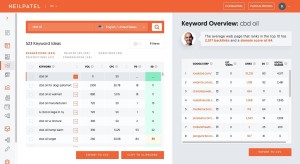
Keyword Research is a key part of Audience Research

Use tools like SEMRush for your audience research
Internal Audience Research
Use the information you already have to make an informed decision about your products’ marketing history, the previous conversion funnel details, and all the persona details about your targeted markets/segments. Use any existing:
Also collect:
Use this information to see where your content should go and how you should position it. Get a good understanding of the questions your customers are asking.
“The strongest buyer personas are based on market research as well as on insights you gather from your actual customer base (through surveys, interviews, etc.).”
Hubspot
With both external and internal research, it’s time to turn that information into the perfect prospect persona and copywriting. Skip the persona part if you already have a clear understanding.
Turn the Info into Your Perfect Prospect Persona
Create a data-driven persona to organize all your audience research into the perfect prospect profile. It’ll focus your content on engaging the audience that is most likely to convert. Segmentation allows you to create customized content for each one reader. A snapshot of your one reader will help you grow your list and sell your products.
“Buyer personas are fictional, generalized representations of your ideal customers.”
Hubspot
What use is a buyer persona if it doesn’t discuss their pain points? Or list competitor products they may have tried? To create a perfect prospect persona, answer the following questions:
Define your one reader’s:
Think about the answers for “before” they use your product, which will come from research. Think about the answers for “after” they use your product, which comes from the benefits they receive from your offer.
Remove the guesswork. Make the connection between your solution and your one reader’s problem using the information from your research about your audience.

Apple gets close to their customer using audience research
Apple is a prime example of how detailed knowledge of your target audience can grow your company. With insight, Apple targets personas by appealing to their core desires.
5 Stages of Awareness
The master copywriter Gene Schwartz created the stages of awareness:
Determine their stage of awareness so you have an understanding of what is motivating them to come to a solution like yours. Their awareness consists of:
One Reader’s Problem
What’s the unresolved frustration or challenge that is standing in their way? And how do they relate that problem to your product?
The best questions to ask are:
One Reader’s Outcome
Break down the outcome your 1 reader wants but hasn’t been achieved. Find compelling messaging that’ll propel your 1 Reader past their problem using your solution. Create the ideal identity for your 1 reader and craft the copy so they’ll live up to it. Your product will provide the desired transformation when your audience buys it because your messaging will speak to their experience.
One Reader’s Desire
Tap into your One Reader’s unfulfilled desire by highlighting the copy that speaks to how they want their life to look. Emotions drive action. Use one of the seven deadly sins to draw the emotions it relates to.
Seven Deadly Sins and Emotions
Once you discover their desires, you find their buying triggers and beliefs. You’ll activate it by knowing their beliefs:
Keep in mind how exposed your 1 reader is to your competitor’s content and what promises there are in your market.
Convert the Audience Research into Messaging
Frame your target audience’s problems into messaging. Join the one reader in their head (especially with your headline). Connect the dots by targeting their pain point and reflecting their motivation/desires into a beneficial value. Highlight the features of your product that correlate to it. Establish your authority so your product is the first thing your one reader thinks of when it comes time to make a purchase.
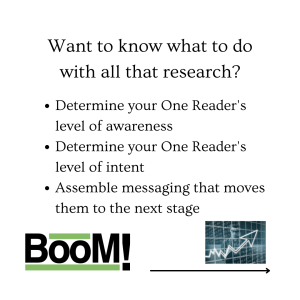
Convert your audience research into converting web copy
Bridge the Benefits
Stress the underlying benefit of the most important feature to your audience. Think about the benefits of your product concerning:
Define the true benefit with the “how” and “why” it connects emotionally to your one reader. Since most people make decisions based on emotions, ensure your copywriting speaks to the right brain.
Messaging Hierarchy
Organize the benefits you found with audience research by hierarchy. List the biggest benefits and the biggest objections in order of importance. Address your one reader’s biggest pain points with the strongest benefits and create a clear path to your offer.
Good Messaging Uses Tactics
There are a ton of effective copywriting formulas to use, so your research will determine what’s the best one to use. Try a few simple copywriting techniques from the following list:
Include everything from their primary motivation to tone, voice, and language. Before you write for your one reader, ensure you understand all these components.
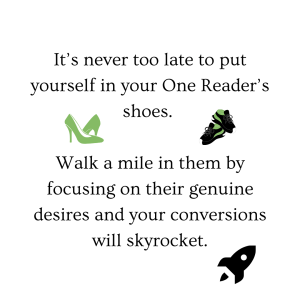
Audience research is always first
Audience Research Conclusion
The more you know about your one reader, the more ability you have to gain their trust. Write for your one reader and not a persona. Build a relationship with your audience but first start by asking them what they want.
Position your messaging correctly, and you’ll have their business every time. Do your research, and your revenue will rise.


Leave a comment